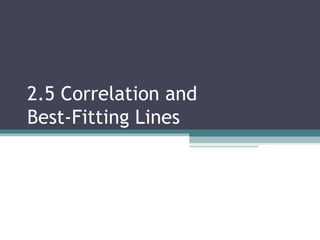
2.5 Correlation and Best Fitting Lines
- 1. 2.5 Correlation and Best-Fitting Lines
- 2. Scatter Plots and Correlation • A __________________ is a graph used to scatter plot check for relationships between paired data. Positive Negative No Correlation Correlation Correlation
- 3. Describe the correlation shown by each scatter plot: • Describe the correlation shown by each scatter plot: Positive correlation, Negative correlation, means as GPA increased, means as GPA increased, Hours Studying tended to Hours of Video Games increase. tended to decrease.
- 4. Approximating Best-Fitting Lines • When data show a positive or negative correlation, you can approximate the data with a _________. line
- 5. To fit a line to data: scatter plot 1. Draw a _________________ of the data. line 2. Sketch the _______ that follows the pattern the closest. There should be as above many points _________ the line as there are below __________. two 3. Choose ______ points on the line and coordinates estimate the ______________ of each point. point-slope form 4. Use ____________________ to write an equation of the line through the two points.
- 6. Example: Fitting a Line to Data • The following data pairs give the average speed of an airplane during the first ten minutes of an airplane flight, with x in minutes and y in miles per hour. Approximate the best-fitting line for the data. x (minutes) 1 2 3 4 5 6 7 8 9 10 y (miles per 180 250 290 310 400 420 410 490 520 510 hour)
- 7. x (minutes) 1 2 3 4 5 6 7 8 9 10 y (miles per hour) 180 250 290 310 400 420 410 490 520 510 Use the fitted line to estimate the speed of an airplane at 5.5 minutes into the flight.
- 8. Your Turn! • The U.S. production of beef from 1990 to 1997 is shown in the table, where x is years since 1990 and y is billions of pounds. Approximate the best-fitting line for the data. Then, use the fitted line to estimate the beef production in the year 2000. x (years) 0 1 2 3 4 5 6 7 y (billions of 22.7 22.9 23.1 23.0 24.4 25.2 25.5 25.5 pounds)
- 9. x (years) 0 1 2 3 4 5 6 7 y (billions of pounds) 22.7 22.9 23.1 23.0 24.4 25.2 25.5 25.5